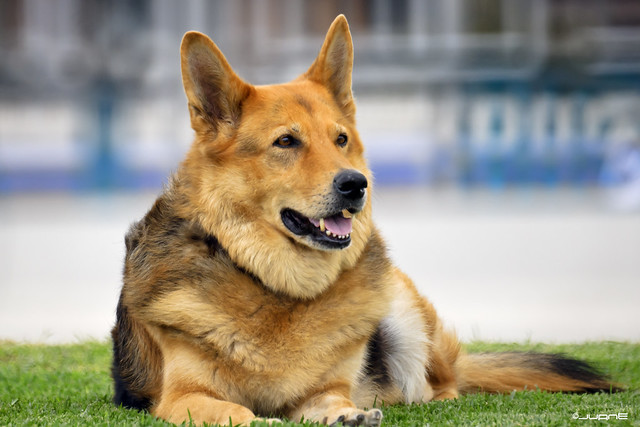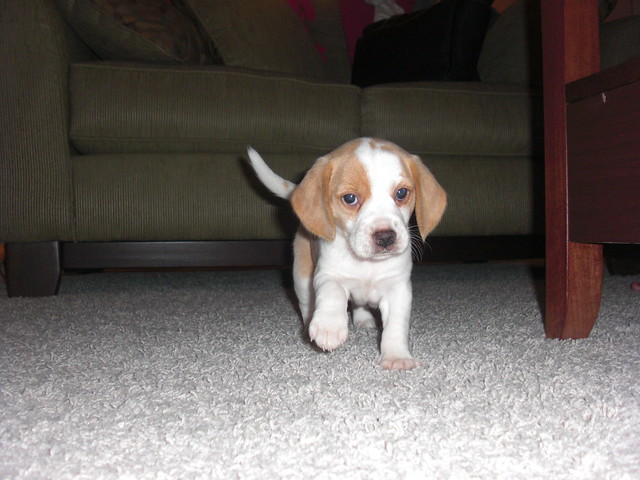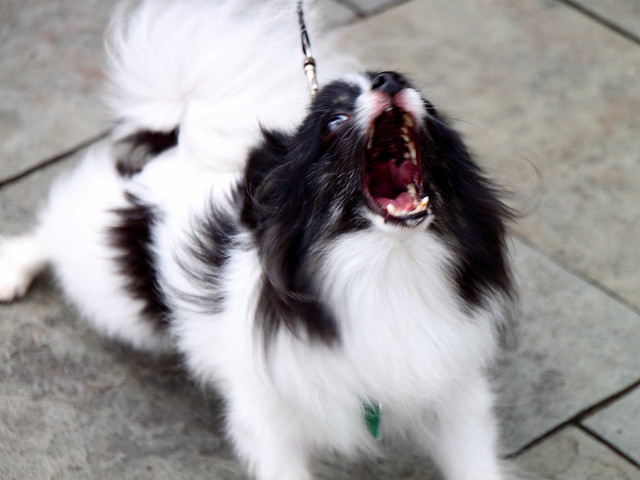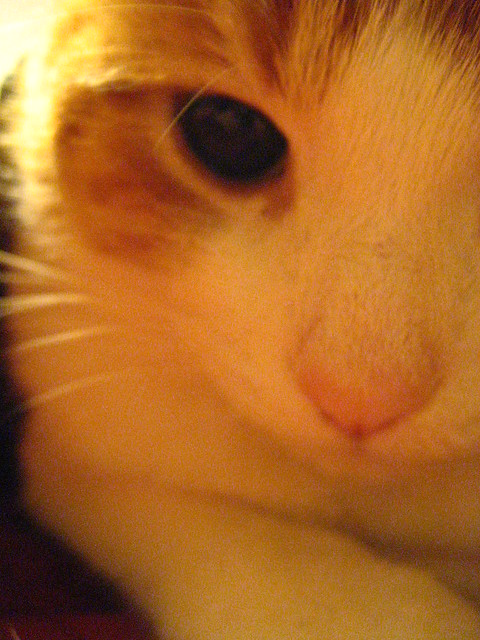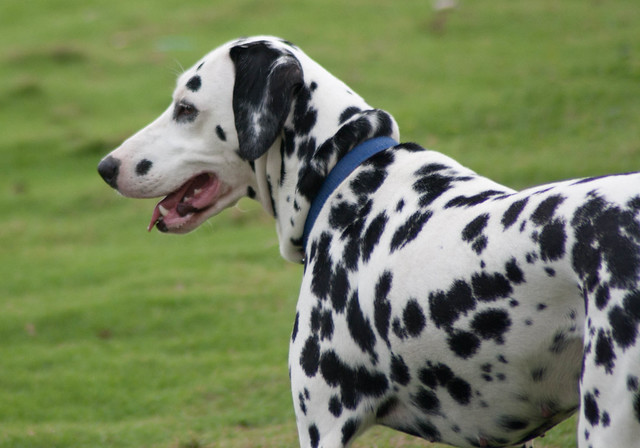(Original Title: Approved Breed Standard of the Great Dane)
 |
| Photo by Laertes |
The standard that determines a breed is a genetic blueprint that describes the ideal to which the breed applies. The breeder should always strive to produce a dog depicted by the breed standard. There is no such thing as a "perfect" dog of any breed, which is why responsible breeders work towards eliminating faults and achieving the highest possible standard. Prior to selecting a Great Dane, a novice should read carefully the standard of this breed.
If the Great Dane is for breeding purposes then it is imperative that the standard is fully understood, and that there is a strong support network consisting of other Great Dane breeders. When looking at litters take a knowledgeable friend with you and do not be afraid to ask questions when interviewing the breeder. You will find a detailed description of the complete breed standard of the Great Dane below, as approved by the American Kennel Club.
1. General Appearance of the Great Dane
The regal stature of this breed should combine strength, power, dignity, and elegance with its sheer size. The body is powerful, smoothly muscled and well-formed. As a giant working breed, its conformation is very well-balanced and it must never be clumsy. Its gait should clearly show a powerful drive coupled with a long reach. A Dane is confident, courageous, spirited, always friendly, never timid and dependable. These physical and mental characteristics give this dog the majestic appearance that is a strong standard of the breed. The dog should portray a great masculinity while the bitch should impress femininity. Any deviation from the true Dane breed type defined in this standard is a very serious flaw.
2. Size, Proportion, and Substance of the Great Dane
Any dog under the permitted height is instantly disqualified from any show. A lack of substance and coarseness of coat are equally undesirable traits.
2.1. The Male Great Dane
The male should have a larger frame, heavier bone structure and be more massive throughout than the bitch. He must appear square in the ratio between length and height. At the shoulder, his minimum height is 30 inches, but it is preferable for him to reach 32 inches or more. However, it is more important that his body is well proportioned to his height.
2.2. The Female Great Dane
The bitch is lighter and smaller than the male. In the ratio between length and height, she is square. If she is well proportioned to her height, then it is permissible for her to have a slightly longer body. At the shoulder, the female cannot be shorter than 28 inches. However, she should reach 30 inches or taller, provided she has a body that is proportionate to her height.
3. The Head of the Great Dane
It is essential that the head of the Great Dane belong, distinguished, and expressive. It is finely chiseled all around, but especially below the eyes. The head is rectangular. When looking at the head from the side, it is important that the bridge of the nose be sharply distinguished from the forehead (you want to see a very pronounced stop before the forehead shapes into the nose). The planes of the muzzle and the skull must appear a straight line and be parallel to each other. Underneath and to the inner point of the eye, the skull plate is smooth and free of bony protuberances. It should flow into a smooth square jaw with a deep muzzle. When looking at the head from the top, the sides of the skull are parallel to each other and straight. The bridge of the nose is as wide as possible. The cheek muscles are proportionate to the rectangular, parallel shape of the head and are not prominent. The tip of the nose to the center of the forehead is the same length as the center of the forehead to the rear of the head. From all sides, the head is angular and has flat planes in direct proportion to the size of the dog. The head of the male is more masculine in appearance than the delicately formed bitch. It is permissible to trim the whiskers or leave them natural.
4. The Eyes of the Great Dane
Deep set, dark, medium-sized eyes with intelligent and alert expressions are the standard of the eyes in this breed. Eye-brows are well-developed with tight, almond-shaped eyelids. Permitted are light colored eyes, different colored eyes, and walleye, but they are not encouraged. Very serious faults are haws and Mongolian eyes.
5. The Ears of the Great Dane
Set high on the head is where the ears are. They are of a moderate thickness and are medium in size. The ears are close to the cheek and folded forward. The top line of the folded ear is horizontal and level with the skull. In the days of Great Danes being wild boar hunters, injury prevention happened by cropping the ears. Wild boars used to gore them and they would get torn whilst running through thick brush. Nowadays, ears are still often cropped. If so, then the ear length is directly proportionate to the size of the head and stands erect.
6. The Nose of the Great Dane
In this breed standard, the nose is black. There are only two exceptions to this rule: in the blue Dane the nose is a dark blue-black, and a spotted black nose is permissible on the Harlequin Dane (with a pink colored nose being very undesirable). A split nose is not permitted and is cause for instant disqualification.
7. The Teeth of the Great Dane
Well developed, clean, strong teeth with full dentition are a must in the breed standard of this dog. A "scissors bite" is preferable. This means the incisors of the lower jaw lightly touch the bottom of the inner upper incisors. Misaligned teeth, crowded incisors, and even bites are faults, albeit minor ones. Overshot jaws and undershot jaws are extremely serious flaws.
8. The Neck, Topline, and Body of the Great Dane
The neck is well arched, high set, firm, long and muscular. The underline of the neck is clean. It should widen and flow smoothly into the withers from the nape. The withers must slope smoothly into a broad, short level back. A deep, wide, well-muscled chest devoid of a pronounced sternum is desirable. The Great Dane should have well-sprung ribs, and the brisket should extend to the elbow. The underline of the body must have a well-defined tuck-up and be tightly muscled. The croup should slope slightly and be broad. A high set tail that flows smoothly into the croup and continues into the spine, should sit a little lower than the level of the back. The base of the tail is broad and tapers evenly down to the hock joint. The tail should fall straight down at rest, and curve slightly when running or excited. However, the curve should never rise above the level of the back. Ring or hooked tails are serious faults and a docked tail is a reason for immediate disqualification.
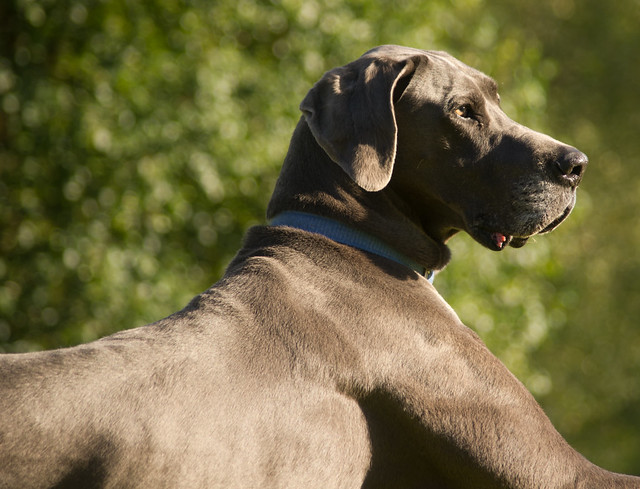 |
| Photo by NJClicks |
9. The Fore-quarters of the Great Dane
When viewed from the side, the fore-quarters are strong and muscular. The shoulder-blade should form as near a right angle as possible where it slopes into the upper arm. There is a perpendicular line from the upper tip of the shoulder to the back of the elbow joint. Well developed, firm and securely attached muscles and ligaments must prevent loose shoulders and hold the shoulder-blade to the rib cage. The length of the upper arm is the same as the length of the shoulder-blade. The elbow is directly halfway between the withers and the ground. The pasterns are strong and should slope slightly. The feet are compact, rounded and have well-arched toes. Toes are straight and do not toe either in or out. There is no rolling of the toes inside or outside. Nails are as dark as possible, strong and kept short. The only time nails are lighter is in the Harlequin Dane. The dewclaw is often removed if desired.
10. The Hindquarters of the Great Dane
The hindquarters should portray strength and width. They are muscular and defined. When viewed from behind, the hock joints are straight and may not turn toward the inside or the outside. As with the front feet, the rear feet are well arched, rounded and straight. They may not toe either in or out. Nails are strong, kept short and are as dark as possible in color. In harlequin Danes, it is permissible for them to have a lighter shade. Wolf claws are undesirable and are serious faults.
11. The Coat of the Great Dane
The coat is glossy and smooth in appearance. It is thick, short and clean.
12. Patterns, Markings, and Colours of the Great Dane
12.1. Fawn Danes
The color fawn is yellow gold. Ideally, the fawn Dane wears a black mask. The rims of the eyes and the eyebrows are black. Often black appears on the ears and the tip of the tail. White markings on the chest or toes (socks) are not desired, and neither are dirty colored black-fronted fawns.
12.2. Brindle Danes
In the brindle Dane, the base color is yellow gold. This is always brindled in a chevron pattern of strong black cross stripes. The brindle Dane should have a black mask, with black appearing on the eyebrows and rims of the eyes. Black may also appear on the tips of the ears and tail. The deeper the base color and the more even and distinct the brindle, the more desired will be the color. It is not desired that they have too much or too little of the brindle coloring. White toes and white markings on the chest are undesirable, along with a black-fronted, dirty colored brindle.
12.3. Blue Danes
Blue Danes are only a pure steel-blue. No other coloring is even considered. It is not desired that the blue Dane have white markings on either the chest or on the toes.
12.4. Black Danes
The black Dane is a pure glossy black. White chest or toe markings are very undesirable.
12.5. Harlequin Danes
In the Harlequin Dane, the base color is a pure, clean white with irregularly, well-distributed black torn patches covering the entire body. It is preferable for the Harlequin Dane to have a completely white neck. The black markings must never be so big that the dog looks like it is wearing a blanket, nor should they be so small that they create a dappled or stippled look. A few small grey patches may occur, as well as a white coat with single black hairs showing through. However, this is not encouraged as it tends to give the dog a salt and pepper look and has a dirty effect, which is most undesired.
Any deviation in color or markings as described above shall be faulted according to its severity. Should a Great Dane fall outside the standard color classifications, it is grounds for instant disqualification. For example, a pure white Dane is definitely not of the breed standard. Usually, a white dog is born blind, often deaf and sometimes both. It is a rare genetic defect that causes them to have a snow-white coat. They are promptly sterilized and never used in any breeding program.
13. The Gait of the Great Dane
The gait of this breed should exude strength. It is powerful with long, easy strides that do not allow for rolling, bouncing or tossing of the body or topline. The line of the back is level and parallel to the ground. The long reach should allow for the front paw to make contact with the ground just below the nose, while the head is then carried forward. The powerful rear drive balances the forward reach. There is a natural tendency for the legs to converge in the centreline of balance underneath the body as speed increases. The elbows or hock joints should not twist in or out while the dog is in motion.
14. Temperament of the Great Dane
Confident, spirited, courageous, always friendly, dependable, never timid, never aggressive and very loyal is the ideal temperament of this breed.
When showing a Great Dane, the breed standard is of utmost importance. When choosing a puppy, be aware of the breed standard. The only breed a dog when fully confident that you understand this. Great Danes with minimum height, having split colored noses, docked tails, or not falling into any group described in "Patterns, Markings or Colours" will be instantly disqualified.
By Mandy Schubach - Article Source: EzineArticles
|

